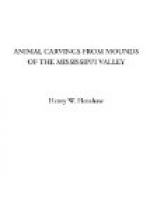If it can safely be assumed that an animal effigy without tusks, without ears, and without a tail was really intended to represent a mastodon, it would be stretching imagination but a step farther to call all the large-bodied, heavy-limbed animal effigies hitherto named bears, mastodons, attributing the lack of trunks, as well as ears, tusks, and tails, to inattention to slight details on the part of the mound artist.
It is true that one bit of good, positive proof is worth many of a negative character. But here the one positive resemblance, the trunk of the supposed elephant, falls far short of an exact imitation, and, as the other features necessary to a good likeness of a mastodon are wholly wanting, is not this an instance where the negative proof should be held sufficient to largely outweigh the positive?
In connection with this question the fact should not be overlooked that, among the great number of animal effigies in Wisconsin and elsewhere, this is the only one which even thus remotely suggests the mastodon. As the Mound Builders were in the habit of repeating the same animal form again and again, not only in the same but in widely distant localities, why, if this was really intended for a mastodon, are there no others like it? It cannot be doubted that the size and extraordinary features of this monster among mammals would have prevented it being overlooked by the Mound-Builders when so many animals of inferior interest engaged their attention. The fact that the mound is a nondescript, with no others resembling it, certainly lessens the probability that it was an intentional representation of the mastodon, and increases the likelihood that its slight resemblance was accidental; a slide of earth from the head, for instance, might readily be interpreted by the modern artist as a trunk, and thus the head be made to assume a shape in his sketch not intended by the original maker. As is well known, no task is more difficult for the artist than to transfer to paper an exact copy of such a subject. Especially hard is it for the artist to avoid unconsciously magnifying or toning down peculiarities according to his own conceptions of what was originally intended, when, as is often the case, time and the elements have combined to render shape and outlines




